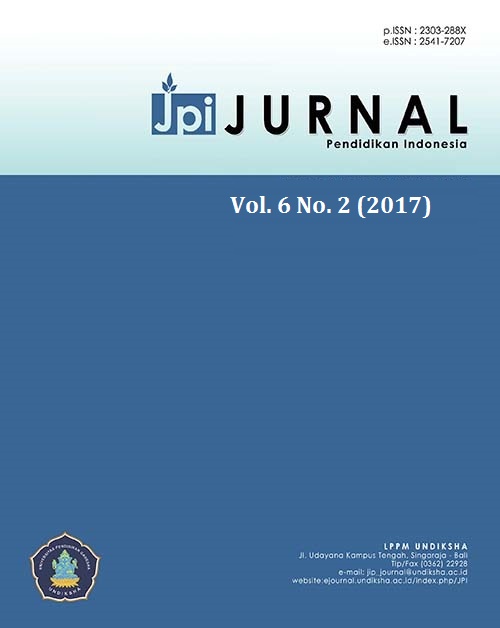The Effect Cooperative Model Type Of SFE Toward Students Social Skills Viewed From The Thinking Styles Characteristics
DOI:
https://doi.org/10.23887/jpi-undiksha.v6i2.11875Kata Kunci:
interaction, learning model, social skills, thinking stylesAbstrak
In the process of learning to occur an interaction between teachers with students or students with other students. Interactions is a good one of the factors that support a learning success. Interactions in this study is the social skills of students. Social skills in question is how students collaborate, deliver opinions, establishing relationships with others, have a sense of empathy, and dare to take decisions. In addition, in the learning process of the students also did a thought process. Thought processes referred to in this study are thinking styles characteristic: concrete sequential (SK), abstract sequential (SA), concrete random (AK), and abstract random (AR). These studies are particularly suited to exploratory Research design to give you an idea of the situation and condition of the students processed. The purpose of this research is to study how the social skills of students viewed from the characteristics of their different thinking styles. The result is students with the characteristics of thinking styles AK has better social skills than other thinking style characteristics. In the process of learning to occur an interaction between teachers with students or students with other students. Interactions is a good one of the factors that support a learning success. Interactions in this study is the social skills of students. Social skills in question is how students collaborate, deliver opinions, establishing relationships with others, have a sense of empathy, and dare to take decisions. In addition, in the learning process of the students also did a thought process. Result this research are 1) The learning model SFE have better social skills rather than direct learning, 2) On each style of thinking gives the same influence toward social skills.
Referensi
Azmir, M., Mat Rahim, A. & Sulaiman, A. (2011). Cooperative Learning Approach to Improve Soft-Skills Among University Students. Elixir Lead, Mgmt. 34(372), 2530-2534.
DePorter, B, & Hernacki, M. (2011). Quantum Teaching and Learning Membiasakan Belajar Nyaman dan Menyenangkan, Bandung: Kaifa.
Fitriani, N.S., Kusmayadi, T.A, & Riyadi. (2016). Eksperimentasi Model Pembelajaran Think Talk Write Dan Numbered Head Together dengan Pendekatan Saintifik Disertai Strategi Peta Konsep Pada Materi Bilangan Ditinjau Dari Gaya Berpikir Siswa Kelas VII SMPN Se-Kota Metro Lampung Tahun Pelajaran 2014/2015. Jurnal Elektronik Pembelajaran Matematika, 4(5), 538-548.
George, P. G. (2010). The Effectiveness of Cooperative Learning Strategies in Multicultur University Classroom. Journal on Excellence in College Teaching, 5(1), 21-30.
Ginnis, P. (2008). Trik & Taktik Mengajar, Strategi Meningkatkan Pencapaian Pengajaran di Kelas. (Terjemahan Wasi Dewanto) California: Corwin Press. (buku asli diterbitkan 2007)
Hargie, O., Dickson, D., Boohan, M., & Hughes, K. (1998). A survey of communication skills training in UK schools of medicine: present practices and prospective proposals, Medical Education, 32, 25–34.
Juliantine, T., Subroto, T., & Yudiana, Y. (2013). Model-Model Pembelajaran Pendidikan Jasmani. Bandung: FPOK UPI.
Liang, T. (2002). Implementing Cooperative Learning In EFL Theacing: Process and Effects. A Thesis For The Degree of Doctor of Philosophy, National Taiwan Normal University.
Merel, K. W., & Gimpel, G. A. (1998). Social skills of children and adolescents: conceptualization, assesment, treatment. Mahwah, NJ: Erlbaum.
Muijs, D. & Reynolds, D. (2008). Effective Teaching Teori dan Aplikasi, Edisi Kedua. Terjemah oleh: Drs. Helly Prajitno Soetjipto, M.A. dan Dra. Sri Mulyantini Soetjipto. Yogyakarta: Pustaka Pelajar.
Nealson, J., & aboud, F. E., (1985). The Resolution of Social Conflict between Friends. Society for Research in Child Development. 56(4), 1009-1017.
Nelson, C. M., & Pearson, C. A. (1991). Integrating services for children and youth with emotional and behavioral disorders. Reston, VA: Council for Exceptional Children.
Sagala, S. (2006). Konsep dan Makna Pembelajaran. Bandung: Alfabeta.
Sardiman, A. M. (2006). Interaksi dan Motivasi Belajar-Mengajar. Jakarta: PT. Raja Grafindo Persada.
Subaer, B. (2013). Profil Penalaran Logis Berdasarkan Gaya Berpikir dalam Memecahkan masalah Fisika Peserta Didik. Pendidikan IPA Indonesia, 2(2), 195-202.
Suningsih, A, Kusmayadi, T.A, & Riyadi. (2014). Eksperimentasi Model Pembelajaran Think Talk Write Dan Think Pairs Share Pada Materi persamaan Garis Lurus Ditinjau Dari cara Berpikir Siswa Kelas Vii Smpn Se-Kabupaten Peringsewu Lampung. Jurnal Elektronik Pembelajaran Matematika, 2(4), 411-421.
Unduhan
Diterbitkan
Terbitan
Bagian
Lisensi
Authors who publish with the Jurnal Pendidikan Indnesia agree to the following terms:
- Authors retain copyright and grant the journal the right of first publication with the work simultaneously licensed under a Creative Commons Attribution License (CC BY-SA 4.0) that allows others to share the work with an acknowledgment of the work's authorship and initial publication in this journal.
- Authors are able to enter into separate, additional contractual arrangements for the non-exclusive distribution of the journal's published version of the work (e.g., post it to an institutional repository or publish it in a book), with an acknowledgment of its initial publication in this journal.
- Authors are permitted and encouraged to post their work online (e.g., in institutional repositories or on their website) prior to and during the submission process, as it can lead to productive exchanges, as well as earlier and greater citation of published work. (See The Effect of Open Access)








